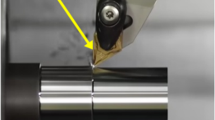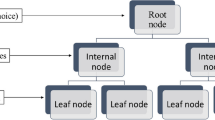Abstract
Metal cutting researchers attempt to develop technology for metal cutting and use of cutting fluids have been continuous due to increasing demands for high productivity. This work reports on the effect of coconut oil under minimum quantity lubrication (MQL) during end milling of AL7049. Dry, wet and MQL approaches are all used to conduct the experimental studies. In contrast to dry and wet machining, it is apparent that MQL generates surfaces with less roughness. A multilayer perceptron (MLP) prediction model was developed considering the real-time dataset with three inputs, and an output that led to prediction of surface roughness. It was analyzed to determine the appropriate activation function and observed that ReLU activation function outpaces sigmoid and tanh and adapted to the proposed solution. K fold cross-validation was done for the developed MLP model with backpropagation to substantiate high accuracy in predictions than KNN and linear regression. The MQL will be good alternative to wet machining and also environmentally friendly machining solution.
Similar content being viewed by others
Abbreviations
- Δwij :
-
Weight of the synaptic link between ith and jth neurons
- ξ :
-
Error or training loss
References
G. Jignesh, K. G. Parmar, A. V. Dave, H. S. Gohil and H. S. Trivedi, Prediction of end milling process parameters using artificial neural network, Materials Today: Proceedings, 38(5) (2021) 3168–3176, https://doi.org/10.1016/j.matpr.2020.09.644.
A. M. Zain, H. Haron and S. Sharif, Prediction of surface roughness in the end milling machining using artificial neural network, Expert Systems with Applications, 37(2) (2010) 1755–1768, https://doi.org/10.1016/j.eswa.2009.07.033.
V. Mundada and S. K. R. Narala, Optimization of milling operations using artificial neural networks (ANN) and simulated annealing algorithm (SAA), Materials Today: Proceedings, 5(2) (2018) 4971–4985, https://doi.org/10.1016/j.matpr.2017.12.075.
A. U. Patwari and A. K. M. Nurul Amin, Artificial intelligence model of surface roughness for end milling operation of steel and its verification by genetic algorithm, Journal of Applied Mechanics and Materials, 110–116 (2012) 3459–3464, https://doi.org/10.4028/www.scientific.net/amm.110-116.3459.
A. Eser, E. A. Ayyıldız, M. Ayyıldız and F. Kara, Artificial intelligence-based surface roughness estimation modelling for milling of AA6061 alloy, Advances in Materials Science and Engineering, 2021 (2021) 5576600, https://doi.org/10.1155/2021/5576600.
G. Ghosh, P. Mandal and S. C. Mondal, Modeling and optimization of surface roughness in keyway milling using ANN, genetic algorithm, and particle swarm optimization, Int. J. Adv. Manuf. Technol., 100 (2019) 1223–1242, https://doi.org/10.1007/s00170-017-1417-4.
M. S. Sukumar, P. Venkata Ramaiah and A. Nagarjuna, Optimization and prediction of parameters in face milling of Al-6061 using taguchi and ANN approach, 12th Global Congress on Manufacturing and Management, GCMM 2014, Procedia Engineering, 97 (2014) 365–371, https://doi.org/10.1016/j.proeng.2014.12.260.
S. Aykut, Surface roughness prediction in machining castamide material using ANN, Acta Polytechnica Hungarica, 8(2) (2011) 21–32.
A. Khorasani and M. R. S. Yazdi, Development of a dynamic surface roughness monitoring system based on artificial neural networks (ANN) in milling operation, Int. J. Adv. Manuf. Technol., 93 (2017) 141–151, https://doi.org/10.1007/s00170-015-7922-4.
S. M. Ali and N. R. Dhar, Modeling of tool wear and surface roughness under MQL condition-a neural approach, Canadian Journal on Artificial Intelligence, Machine Learning & Pattern Recognition, 1(2) (2010) 830–839.
V. A. Mechiri Sandeep Kumar, K. Murumulla and T. Sathvik, Surface roughness prediction using machine learning algorithms while turning under different lubrication conditions, J. Phys.: Conf. Ser., 2070 (2021) 012243.
S. M. Ali and N. R. Dhar, Tool wear and surface roughness prediction using an artificial neural network (ANN) in turning steel under minimum quantity lubrication (MQL), World Academy of Science, Engineering and Technology, International Journal of Mechanical, Aerospace, Industrial, Mechatronic and Manufacturing Engineering, 4(2) (2010) 250–259.
V. Dubey, A. K. Sharma and D. Y. Pimenov, Prediction of surface roughness using machine learning approach in MQL turning of AISI 304 steel by varying nanoparticle size in the cutting fluid, Lubricants, 10(5) (2022) 81, https://doi.org/10.3390/lubricants10050081.
K. Anand Babu, G. Vijaya Kumar and P. Venkataramaiah, Prediction of surface roughness in drilling of Al 7075/10 % - SiCp composite under MQL condition using fuzzy logic, Indian Journal of Science and Technology, 8 (2015) 1–10.
D. Cica, B. Sredanovic, G. Lakic-Globocki and D. Kramar, Modeling of the cutting forces in turning process using various methods of cooling and lubricating: An artificial intelligence approach, Advances in Mechanical Engineering (2013) https://doi.org/10.1155/2013/798597.
P. P. Powar, Investigations into effect of cutting conditions on surface roughness under MQL turning of AISI 4340 by ANN models, Journal of Mines, Metals and Fuels, 70(8A) (2022) 404–418.
R. Karim, F. Dilwar and R. A. Siddique, Predictive modeling of surface roughness in MQL assisted turning of SiC-Al alloy composites using artificial neural network and adaptive neuro fuzzy inference system, Advancement in Mechanical Engineering and Technology, 5 (2019) 12–28.
F. Aggogeri, N. Pellegrini and F. L. Tagliani, Recent advances on machine learning applications in machining processes, Applied Sciences, 11(18) (2021) 8764.
M. Soori, B. Arezoo and R. Dastres, Machine learning and artificial intelligence in CNC machine tools, a review, Sustainable Manufacturing and Service Economics, 2 (2023) 100009, https://doi.org/10.1016/j.smse.2023.100009.
Author information
Authors and Affiliations
Corresponding author
Additional information
Lavanya G holds U.G. degree in Electrical and Electronics Engineering, P.G. degree in Information Technology, and a Ph.D., in Information and Communication Technology. With an impressive career spanning 23 years in teaching and 5 years dedicated to research, her contributions to the field of academia are substantial. Her commitment to education extends beyond teaching, as she has actively contributed to research projects and published 12 papers in prestigious journals. Her passion for machine learning and IoT enables to contribute in develo** technological advancements.
Sundaramurthy K is currently working as Professor in Department of Mechanical Engineering, Paavai Engineering College, India. He obtained his Ph.D. in machining studies from Anna University, Chennai, India in 2013. He obtained his Master’s degree in CAD/CAM from VIT University, Vellore, India in 2003 and Bachelor’s degree in Mechanical Engineering from Madras University, India in 2000. His areas of interests are study of machining parameters, optimization using soft computing techniques and environment friendly machining techniques. He is having 20 years of experience in teaching. Presently, he is guiding 7 research scholars.
Subburam V is working as a Professor in the Department of Mechanical Engineering at Paavai Engineering College, Tamilnadu, India. He received his Bachelor’s degree in Mechanical Engineering from Madras University and Master’s degree in Product Design and Development from Anna University, Chennai, India. He earned his Ph.D. from Anna University, Chennai, India. His research interests includes micromachining, composite materials and machining studies. He is having vast experience in teaching and research with many publications.
Makesh M is a Professor at Paavai Engineering College, Tamil Nadu, India. He completed his U.G. in 1998 in Madras University, India and earned his Master’s degree in 2007 and Ph.D. in 2019 from Anna University, Chennai, India. He is having research and teaching experience of 23 years. His areas of interest are machining studies, welding and hot corrosion. He has published 15 national and international journals.
Rights and permissions
About this article
Cite this article
Lavanya, G., Sundaramurthy, K., Subburam, V. et al. Intelligent prediction using AI-based modeling and optimization of surface roughness in Al7049 end milling with coconut oil under minimum quantity lubrication. J Mech Sci Technol 38, 2005–2014 (2024). https://doi.org/10.1007/s12206-024-0332-5
Received:
Revised:
Accepted:
Published:
Issue Date:
DOI: https://doi.org/10.1007/s12206-024-0332-5




